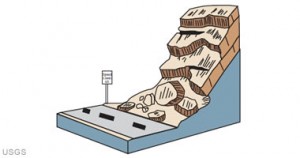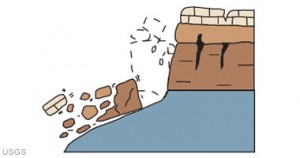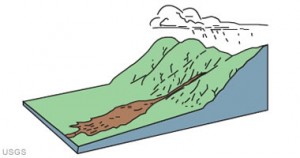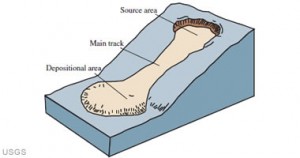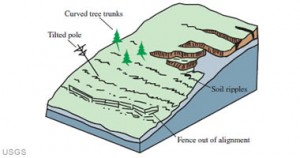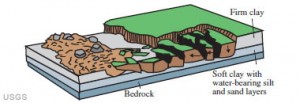Landslides
Landslide Questions
What is a landslide?
A landslide is defined as the movement of a mass of rock, debris, or earth down a slope due to gravity. The materials may move by falling, toppling, sliding, spreading, or flowing.
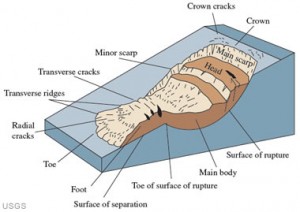
What causes a landslide?
Almost every landslide has multiple causes. Slope movement occurs when forces acting down-slope (mainly due to gravity) exceed the strength of the earth materials that compose the slope. Landslides can be triggered by rainfall, snowmelt, changes in water level, stream erosion, changes in ground water, earthquakes, volcanic activity, disturbance by human activities, or any combination of these factors.
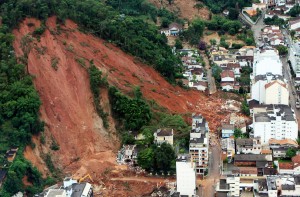
What are submarine landslides?
Earthquake shaking and other factors can also induce landslides underwater. These landslides are called submarine landslides. Submarine landslides sometimes cause tsunamis that damage coastal areas.
Where do landslides occur?
Landslides in the United States occur in all 50 States. The primary regions of landslide occurrence and potential are the coastal and mountainous areas of California, Oregon, and Washington, the States comprising the intermountain west, and the mountainous and hilly regions of the Eastern United States. Alaska and Hawaii also experience all types of landslides.
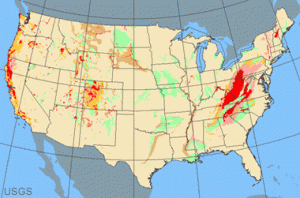
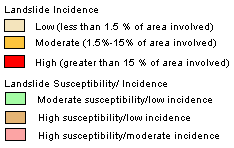
How fast do landslide travel?
Landslides can move slowly, (millimeters per year) or can move quickly and disastrously, as is the case with debris flows. Debris flows can travel down a hillside at speeds up to 200 miles per hour (more commonly, 30 – 50 miles per hour), depending on the slope angle, water content, volume of debris, and type of earth and debris in the flow. These flows are initiated by heavy periods of rainfall, but sometimes can happen as a result of short bursts of concentrated rainfall or other factors in susceptible areas. Burned areas charred by wildfires are particularly susceptible to debris flows, given certain soil characteristics and slope conditions.
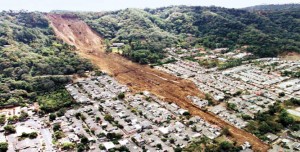
Why study landslides?
Landslides are a serious geologic hazard. It is estimated that in the United States they cause in excess of $1 billion in damages and from about 25 to 50 deaths each year. Globally, landslides cause billions of dollars in damages and thousands of deaths and injuries each year.
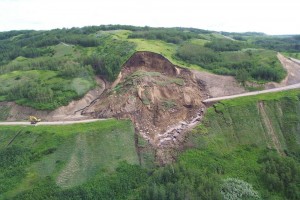
Who is most at risk for landslides?
As people move into new areas of hilly or mountainous terrain, it is important to understand the nature of their potential exposure to landslide hazards, and how cities, towns, and counties can plan for land-use, engineering of new construction and infrastructure, and other measures which will reduce the costs of living with landslides. Although the physical causes of many landslides cannot be removed, geologic investigations, good engineering practices, and effective enforcement of land-use management regulations can reduce landslide hazards.
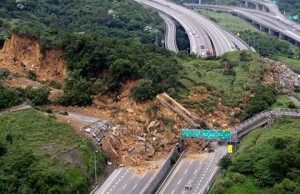
Do human activities cause landslides?
Yes, in some cases human activities can be a contributing factor in causing landslides. Many human-caused landslides can be avoided or mitigated. They are commonly a result of building roads and structures without adequate grading of slopes, of poorly planned alteration of drainage patterns, and of disturbing old landslides.
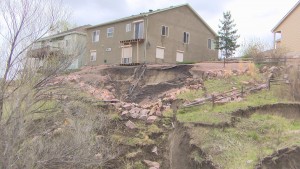
Where can I find landslide information for my area?
The USGS National Landslide Information Center (NLIC) is a part of the U.S. Geological Survey Landslide Hazards Program that collects and distributes all forms of information related to landslides. The NLIC is designed to serve landslide researchers, geotechnical practitioners engaged in landslide stabilization, and anyone else concerned in any way with landslide education, hazard, safety, and mitigation. Every state in the US has a geoscience agency and most have some landslide information. The Association of American State Geologists provides links to the State Geologist for every state.
What was the most expensive landslide to fix in the United States?
The Thistle, Utah, landslide cost in excess of $200 million dollars to fix. The landslide occurred during the spring of 1983, when unseasonably warm weather caused rapid snowmelt to saturate the slope. The landslide destroyed the railroad tracks of the Denver and Rio Grande Western Railway Company, and the adjacent Highway 89. It also flowed across the Spanish Fork River, forming a dam. The impounded river water inundated the small town of Thistle. The inhabitants of the town of Thistle, directly upstream from the landslide, were evacuated as the lake began to flood the town, and within a day the town was completely covered with water. Populations downstream from the dam were at risk because of the possible overtopping of the landslide by the lake. This could cause a catastrophic outburst of the dam with a massive flood downstream. Eventually, a drain system was engineered to drain the lake and avert the potential disaster.

How many deaths result from landslides?
An average of between 25 and 50 people are killed by landslides each year in the United States. The worldwide death toll per year due to landslides is in the thousands. Most landslide fatalities are from rock fall, debris-flows, or volcanic debris flows.
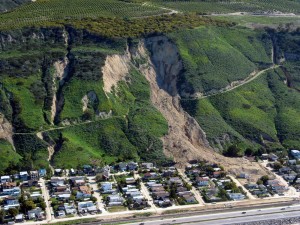
What should I know about wildfires and debris flows?
Wild land fires are inevitable in the western United States. Expansion of human development into forested areas has created a situation where wildfires can adversely affect lives and property, as can the flooding and landslides that occur in the aftermath of the fires. There is a need to develop tools and methods to identify and quantify the potential hazards posed by landslides produced from burned watersheds. Post-fire landslide hazards include fast-moving, highly destructive debris flows that can occur in the years immediately after wildfires in response to high intensity rainfall events, and those flows that are generated over longer time periods accompanied by root decay and loss of soil strength. Post-fire debris flows are particularly hazardous because they can occur with little warning, can exert great impulsive loads on objects in their paths, and can strip vegetation, block drainage ways, damage structures, and endanger human life. Wildfires could potentially result in the destabilization of pre-existing deep-seated landslides over long time periods.
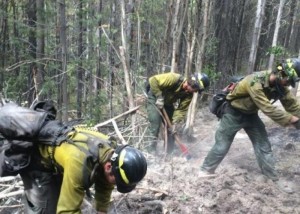
How do landslides cause tsunamis?
Tsunamis are large, potentially deadly and destructive sea waves, most of which are formed as a result of submarine earthquakes. They may also result from the eruption or collapse of island or coastal volcanoes and the formation of giant landslides on marine margins. These landslides, in turn, are often triggered by earthquakes. Tsunamis can be generated on impact as a rapidly moving landslide mass enters the water or as water displaces behind and ahead of a rapidly moving underwater landslide.
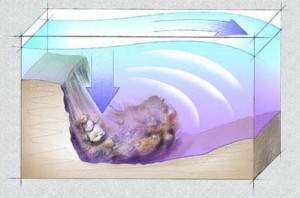
What are some examples of landslides that have caused tsunamis?
The 1964 Alaska earthquake caused 115 deaths in Alaska alone, with 106 of those due to tsunamis generated by tectonic uplift of the sea floor, and by localized subareal and submarine landslides. The earthquake shaking caused at least 5 local slide-generated tsunamis within minutes after the shaking began. An eyewitness account of the tsunami caused by the movement and landslides of the 1964 Alaska earthquake.
Research in the Canary Islands concludes that there have been at least five massive volcano landslides that occurred in the past, and that similar large events may occur in the future. Giant landslides have the potential of generating large tsunami waves at close and also very great distances and would have the potential to devastate large areas of coastal land as far away as the eastern seaboard of North America.
Rock falls and rock avalanches in coastal inlets, such as those that have occurred in the past at Tidal Inlet, Glacier Bay National Park, Alaska, have the potential to cause regional tsunamis that pose a hazard to coastal ecosystems and human settlements. On July 9, 1958, a magnitude M 7.9 earthquake on the Fairweather Fault triggered a rock avalanche at the head of Lituya Bay, Alaska. The landslide generated a wave that ran up 524 m on the opposite shore and sent a 30-m high wave through Lituya Bay, sinking two of three fishing boats and killing two persons.
How soon does the danger of landslides end after the rain stops?
It’s not possible to exactly predict the number of days or weeks that landslides remain a danger after heavy rain. Residents near mountain slopes, canyons, and landslide prone areas should stay alert even after heavy rain subsides.
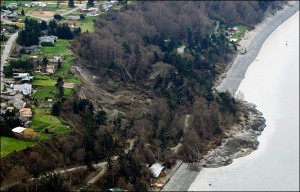
Why is southern California vulnerable to landslides?
Areas that have been burned by recent wildfires are highly susceptible to debris-flow activity that can be triggered by significantly less rainfall than that which triggers debris flows from unburned hill slopes.
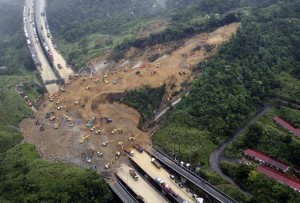
What was the biggest landslide in the world?
The world’s biggest historic landslide occurred during the 1980 eruption of Mount St. Helens, a volcano in the Cascade Mountain Range in the State of Washington, USA. The volume of material was 2.8 cubic kilometers (km).
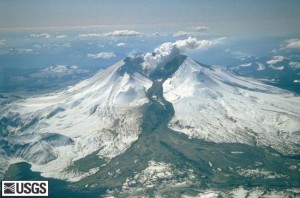
What was the biggest prehistoric landslide?
The world’s biggest prehistoric landslide, discovered so far on land, is in southwestern Iran, and is named the Saidmarreh landslide. The landslide is located on the Kabir Kuh anticline in Southwest Iran at 33 degrees north latitude, 47.65 degrees east longitude. The landslide has a volume of about 20 cubic kilometers, a depth of 300 m, a travel distance of 14 km and a width of 5 km. This means that about 50 billion tons of rock moved in this single event!
Types of Landslides
Rotational slide: This is a slide in which the surface of rupture is curved concavely upward and the slide movement is roughly rotational about an axis that is parallel to the ground surface and transverse across the slide.
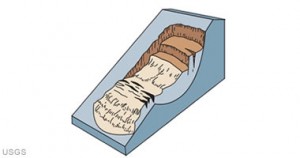
Translational slide: In this type of slide, the landslide mass moves along a roughly planar surface with little rotation or backward tilting.
Block slide: is a translational slide in which the moving mass consists of a single unit or a few closely related units that move downslope as a relatively coherent mass.
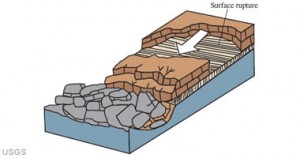
Fall: Falls are abrupt movements of masses of geologic materials, such as rocks and boulders, that become detached from steep slopes or cliffs. Separation occurs along discontinuities such as fractures, joints, and bedding planes, and movement occurs by free-fall, bouncing, and rolling. Falls are strongly influenced by gravity, mechanical weathering, and the presence of interstitial water.
Topple: Toppling failures are distinguished by the forward rotation of a unit or units about some pivotal point, below or low in the unit, under the actions of gravity and forces exerted by adjacent units or by fluids in cracks.
Debris flow: A debris flow is a form of rapid mass movement in which a combination of loose soil, rock, organic matter, air, and water mobilize as a slurry that flows downslope. Debris flows include less than 50% fines. Debris flows are commonly caused by intense surface-water flow, due to heavy precipitation or rapid snowmelt, that erodes and mobilizes loose soil or rock on steep slopes. Debris flows also commonly mobilize from other types of landslides that occur on steep slopes, are nearly saturated, and consist of a large proportion of silt- and sand-sized material. Debris-flow source areas are often associated with steep gullies, and debris-flow deposits are usually indicated by the presence of debris fans at the mouths of gullies. Fires that denude slopes of vegetation intensify the susceptibility of slopes to debris flows.
Debris avalanche: This is a variety of very rapid to extremely rapid debris flow.
Earthflow: Earthflows have a characteristic “hourglass” shape. The slope material liquefies and runs out, forming a bowl or depression at the head. The flow itself is elongate and usually occurs in fine-grained materials or clay-bearing rocks on moderate slopes and under saturated conditions. However, dry flows of granular material are also possible.
Mudflow: A mudflow is an earthflow consisting of material that is wet enough to flow rapidly and that contains at least 50 percent sand-, silt-, and clay-sized particles. In some instances, for example in many newspaper reports, mudflows and debris flows are commonly referred to as “mudslides.”
Creep: Creep is the imperceptibly slow, steady, downward movement of slope-forming soil or rock. Movement is caused by shear stress sufficient to produce permanent deformation, but too small to produce shear failure. There are generally three types of creep: (1) seasonal, where movement is within the depth of soil affected by seasonal changes in soil moisture and soil temperature; (2) continuous, where shear stress continuously exceeds the strength of the material; and (3) progressive, where slopes are reaching the point of failure as other types of mass movements. Creep is indicated by curved tree trunks, bent fences or retaining walls, tilted poles or fences, and small soil ripples or ridges.
Lateral Spreads: Lateral spreads are distinctive because they usually occur on very gentle slopes or flat terrain. The dominant mode of movement is lateral extension accompanied by shear or tensile fractures. The failure is caused by liquefaction, the process whereby saturated, loose, cohesionless sediments (usually sands and silts) are transformed from a solid into a liquefied state. Failure is usually triggered by rapid ground motion, such as that experienced during an earthquake, but can also be artificially induced. When coherent material, either bedrock or soil, rests on materials that liquefy, the upper units may undergo fracturing and extension and may then subside, translate, rotate, disintegrate, or liquefy and flow. Lateral spreading in fine-grained materials on shallow slopes is usually progressive. The failure starts suddenly in a small area and spreads rapidly. Often the initial failure is a slump, but in some materials movement occurs for no apparent reason. Combination of two or more of the above types is known as a complex landslide.
SLIDES: Although many types of mass movements are included in the general term “landslide,” the more restrictive use of the term refers only to mass movements, where there is a distinct zone of weakness that separates the slide material from more stable underlying material. The two major types of slides are rotational slides and translational slides.
FLOWS: There are five basic categories of flows that differ from one another in fundamental ways. Although there are multiple types of causes of landslides, the three that cause most of the damaging landslides around the world are these:
- Landslides and Water: Slope saturation by water is a primary cause of landslides. This effect can occur in the form of intense rainfall, snowmelt, changes in ground-water levels, and waterlevel changes along coastlines, earth dams, and the banks of lakes, reservoirs, canals, and rivers. Landsliding and flooding are closely allied because both are related to precipitation, runoff, and the saturation of ground by water. In addition, debris flows and mudflows usually occur in small, steep stream channels and often are mistaken for floods; in fact, these two events often occur simultaneously in the same area. Landslides can cause flooding by forming landslide dams that block valleys and stream channels, allowing large amounts of water to back up. This causes backwater flooding and, if the dam fails, subsequent downstream flooding. Also, solid landslide debris can “bulk” or add volume and density to otherwise normal streamflow or cause channel blockages and diversions creating flood conditions or localized erosion. Landslides can also cause overtopping of reservoirs and/or reduced capacity of reservoirs to store water.
- Landslides and Seismic Activity: Many mountainous areas that are vulnerable to landslides have also experienced at least moderate rates of earthquake occurrence in recorded times. The occurrence of earthquakes in steep landslide-prone areas greatly increases the likelihood that landslides will occur, due to ground shaking alone or shaking- caused dilation of soil materials, which allows rapid infiltration of water. The 1964 Great Alaska Earthquake caused widespread landsliding and other ground failure, which caused most of the monetary loss due to the earthquake. Other areas of the United States, such as California and the Puget Sound region in Washington, have experienced slides, lateral spreading, and other types of ground failure due to moderate to large earthquakes. Widespread rockfalls also are caused by loosening of rocks as a result of ground shaking. Worldwide, landslides caused by earthquakes kill people and damage structures at higher rates than in the United States.
- Landslides and Volcanic Activity: Landslides due to volcanic activity are some of the most devastating types. Volcanic lava may melt snow at a rapid rate, causing a deluge of rock, soil, ash, and water that accelerates rapidly on the steep slopes of volcanoes, devastating anything in its path. These volcanic debris flows (also known as lahars) reach great distances, once they leave the flanks of the volcano, and can damage structures in flat areas surrounding the volcanoes. The 1980 eruption of Mount St. Helens, in Washington triggered a massive landslide on the north flank of the volcano, the largest landslide in recorded times.
Landslide Mitigation – How to Reduce the Effects of Landslides: Vulnerability to landslide hazards is a function of location, type of human activity, use, and frequency of landslide events. The effects of landslides on people and structures can be lessened by total avoidance of landslide hazard areas or by restricting, prohibiting, or imposing conditions on hazard-zone activity. Local governments can reduce landslide effects through land-use policies and regulations. Individuals can reduce their exposure to hazards by educating themselves on the past hazard history of a site and by making inquiries to planning and engineering departments of local governments. They can also obtain the professional services of an engineering geologist, a geotechnical engineer, or a civil engineer, who can properly evaluate the hazard potential of a site, built or unbuilt.
The hazard from landslides can be reduced by avoiding construction on steep slopes and existing landslides, or by stabilizing the slopes. Stability increases when groundwater is prevented from rising in the landslide mass by (1) covering the landslide with an impermeable membrane, (2) directing surface water away from the landslide, (3) draining groundwater away from the landslide, and (4) minimizing surface irrigation. Slope stability is also increased when a retaining structure and/ or the weight of a soil/rock berm are placed at the toe of the landslide or when mass is removed from the top of the slope.
Landslide Definitions
LANDSLIDE ADVISORY – a general statement about the potential of landslide activity in a given region relative to developing rainfall predictions. An advisory may include general statements about rainfall conditions that can lead to debris-flow activity, and list precautions to be taken in the event of heavy rainfall.
LANDSLIDE WATCH – means that landslide-activity will be possible, but is not imminent. People in, or planning to travel through, a watch area should check preparedness and stay informed about developing weather patterns.
LANDSLIDE WARNING – indicates that landslide activity is presently occurring and extreme caution should be taken.
FLOOD WATCH – means that an overflow of water from a river is possible for your area.
FLASH FLOOD WATCH – means that flash flooding is possible in or close to the watch area. Flash Flood Watches can be put into effect for as long as 12 hours, while heavy rains move into and across the area.
FLOOD WARNING – means flooding conditions are actually occurring in the warning area.
FLASH FLOOD WARNING – means that flash flooding is actually occurring in the warning area. A warning can also be issued as a result of torrential rains, a dam failure or snow thaw.
URBAN and SMALL STREAM ADVISORY– means flooding of small streams, streets and low-lying areas, such as railroad underpasses and urban storm drains is occurring.
DEBRIS – The scattered remains of something broken or destroyed; rubble or wreckage.
DEBRIS FLOW – A churning, water-saturated mass of rock, soil and organic matter that rushes down mountain slopes, typically originating as a landslide.
GRAVITY – The natural force of attraction exerted by a celestial body, such as Earth, upon objects at or near its surface, tending to draw them toward the center of the body.
FRICTION – Force that resists the relative motion or tendency to such motion of two bodies in contact.
TRIGGER – An event that initiates a landslide.
Click Here to see if there are any active warnings in your area.
Landslide Safety
BEFORE A LANDSLIDE: Avoid building near steep slopes, close to mountain edges, near drainage ways, or natural erosion valleys. Get a ground assessment of your property. Landslides occur where they have before, and in identifiable hazard locations. Ask for information on landslides in your area, specific information on areas vulnerable to landslides, and request a professional referral for a very detailed site analysis of your property, and corrective measures you can take, if necessary. Watch the patterns of storm-water drainage near your home, and note the places where runoff water converges, increasing flow in channels. These are areas to avoid during a storm. Make evacuation plans. Plan at least two evacuation routes since roads may become blocked or closed. Develop your own emergency plan for your family or business.
MINIMIZE HOME HAZARDS: Have flexible pipe fittings installed to avoid gas or water leaks, as flexible fittings are more resistant to breakage. Plant ground cover on slopes and build retaining walls. In mudflow areas, build channels or deflection walls to direct the flow around buildings. Remember: If you build walls to divert debris flow and the flow lands on a neighbor’s property, you may be liable for damages. Design and construction of walls and channels strong enough to resist or divert landslides is highly specialized work, best done by qualified professionals.
DURING A STORM/LANDSLIDE: Stay alert and awake. Many debris-flow fatalities occur when people are sleeping. Listen to a NOAA Weather Radio or portable, battery-powered radio or television for warnings of intense rainfall. Be aware that intense, short bursts of rain may be particularly dangerous, especially after longer periods of heavy rainfall and damp weather. If you are in areas susceptible to landslides and debris flows, consider leaving if it is safe to do so. Remember that driving during an intense storm can be hazardous. If you remain at home, move to a second story if possible. Staying out of the path of a landslide or debris flow saves lives. Listen for any unusual sounds that might indicate moving debris, such as trees cracking or boulders knocking together. A trickle of flowing or falling mud or debris may precede larger landslides. Moving debris can flow quickly and sometimes without warning. If you are near a stream or channel, be alert for any sudden increase or decrease in water flow and for a change from clear to muddy water. Such changes may indicate landslide activity upstream, so be prepared to move quickly. Don’t delay! Save yourself, not your belongings. Be especially alert when driving. Bridges may be washed out, and culverts overtopped. Do not cross flooding streams…Turn Around, Don’t Drown! Embankments along roadsides are particularly susceptible to landslides. Watch the road for collapsed pavement, mud, fallen rocks, and other indications of possible debris flows. Be aware that strong shaking from earthquakes can induce or intensify the effects of landslides.
AFTER A LANDSLIDE: Stay away from the slide area. There may be danger of additional slides. Check for injured and trapped persons near the slide area. Give first aid if trained. Remember to help your neighbors who may require special assistance–infants, elderly people, and people with disabilities. Listen to a battery-operated radio or television for the latest emergency information. Remember that flooding may occur after a mudflow or a landslide. Check for damaged utility lines. Report any damage to the utility company. Check the building foundation, chimney, and surrounding land for damage. Replant damaged ground as soon as possible since erosion caused by loss of ground cover can lead to flash flooding. Seek the advice of geotechnical expert for evaluating landslide hazards or designing corrective techniques to reduce landslide risk.
Landslide Activities
Lesson Plan: Here is a great lesson plan on erosion and landslides.
Lesson Plan: Here is a great lesson plan on landslides for grades 6-8.
Lesson Plan: This lesson consists of landslides, liquefaction, and structural failure caused by earthquakes.
Science Fair Project Ideas: Here is a complete list of science fair project ideas. Discover the science behind the weather that impacts us every day.


